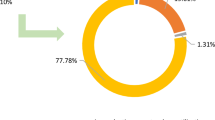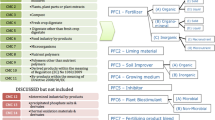Abstract
Fertilizer production is one of the most important industries for ensuring a growing demand for food resources. Regrettably, this industry is characterized by high energy intensity. Even today, fossil fuel such as natural gas is the main raw material and the main source of primary energy in nitrogen fertilizer production. According to the data of the Ministry of Energy of the Republic of Lithuania, about 40 % of total natural gas consumption in Lithuania is used in the fertilizer production company. Evaluation of the possibilities to reduce energy intensity and use alternative resources in nitrogen fertilizer production is the main objective of this research. All the technological processes of nitrogen fertilizer production in the analyzed company are objects of research of this work. Recent researches into the area of cleaner chemical product production are reviewed and systematized. The methods of cleaner production (CP), industrial ecology, material flow analysis, environmental impact assessment, and evaluation of environmental efficiency are integrated into the methodology of this work. Results of the initial environmental analysis of nitrogen fertilizer production processes show that the analyzed company has already implemented several CP projects with a view to minimizing energy intensity and air emissions. Despite their efforts, an enormous amount of energy is wasted in the main and additional processes (for example, ammonia production, cooling process, and heat energy production). Several alternatives for resource efficiency and energy saving have been suggested when doing the research. This paper presents the results of the feasibility analysis of three case studies in which pollution prevention methods are applied jointly with industrial symbiosis.



Similar content being viewed by others
References
Ahlgren S, Baky A, Bernesson S et al (2008) Ammonium nitrate fertiliser production based on biomass: environmental effects from a life cycle perspective. Bioresour Technol 99:8034–8041. doi:10.1016/j.biortech.2008.03.041
Ahlgren S, Bernesson S, Nordberg K, Hansson P-A (2010) Nitrogen fertiliser production based on biogas: energy input, environmental impact and land use. Bioresour Technol 101:7192–7195. doi:10.1016/j.biortech.2010.04.006
Appl M (2012) Ullmann’s encyclopedia of industrial chemistry. Wiley-VCH Verlag GmbH & Co. KGaA, Weinheim
Barbier J, Oliviero L, Renard B, Duprez D (2002) Catalytic wet air oxidation of ammonia over M/CeO2 catalysts in the treatment of nitrogen-containing pollutants. Catal Today 75:29–34
Bauer F, Persson T, Hulteberg C, Tamm D (2013) Biogas upgrading: technology overview, comparison and perspectives for the future. Biofuels Bioprod Biorefining 7:499–511. doi:10.1002/bbb.1423
Chaubey R, Sahu S, James OO, Maity S (2013) A review on development of industrial processes and emerging techniques for production of hydrogen from renewable and sustainable sources. Renew Sustain Energy Rev 23:443–462
Cordis project. Industrial Sector: Chemicals (2009) A technological breakthrough in radiant efficiency: major fuel saving on a steam reforming furnace. In: Proj. No 0031/94/NL. http://cordis.europa.eu/opet/fiches/rue-5.htm
Dawson CJ, Hilton J (2011) Fertiliser availability in a resource-limited world: production and recycling of nitrogen and phosphorus. Food Policy 36:S14–S22. doi:10.1016/j.foodpol.2010.11.012
Foglia D, Wukovits W, Friedl A et al (2011) Effects of feedstocks on the process integration of biohydrogen production. Clean Technol Environ Policy 13:547–558. doi:10.1007/s10098-011-0351-7
Gefeniene A, Kauspediene D, Snukiskis J (2006) Performance of sulphonic cation exchangers in the recovery of ammonium from basic and slight acidic solutions. J Hazard Mater 135:180–187. doi:10.1016/j.jhazmat.2005.11.042
Gilbert P, Alexander S, Thornley P, Brammer J (2014) Assessing economically viable carbon reductions for the production of ammonia from biomass gasification. J Clean Prod 64:581–589. doi:10.1016/j.jclepro.2013.09.011
Institute of Environmental Engineering (2010) Soil-concept. Generation of fuel: pelleting press monitoring report. ENERCOM project. P–17
Jorquera O, Kalid R, Kiperstok A et al (2013) Effluent stream treatment in a nitrogenous fertilizer factory: an exergy analysis for process integration. Process Saf Environ Prot 92:862–868. doi:10.1016/j.psep.2013.07.003
Jucevicius R, Jucevicius G, Rybakovas E, Zebrauskiene J (2010) Lietuvos chemijos produktų gamybos pramonės konkurencingumas: mokslo studija. (Compitetiveness of Lithuanian Chemical products manufacturing industry: a scientific study). Kaunas
Kliopova I, Makarskiene K (2013) Generation of solid recovered fuel from the separate fraction of pre-composted materials (Sewage Sludge and Biomass Residues). Environ Res Eng Manag 2:5–18
Kliopova I, Staniskis JK (2006) The evaluation of cleaner production performance in Lithuanian industries. J Clean Prod 14:1561–1575. doi:10.1016/j.jclepro.2005.04.017
Kliopova I, Knasyte M, Staniskis JK (2011) Lietuvos ūkio aprūpinimo svarbiausiomis žaliavomis esamos ir prognozuojamos ateityje situacijos ir šios situacijos poveikio Lietuvos konkurencingumui analizės studija. Study of current and predicted situation of Lithuanian economy supply with critical Ra. Vilnius
Kliopova I, Malinauskiene M, Baranauskaite I (2014) Feasibility analysis of resource efficient innovations for cleaner ammonia fertilizer production. Final report of scientific research project. P-160. Kaunas
Knašyte M, Kliopova I, Staniškis JK (2012) Economic importance, supply and environmental risks of imported resources in Lithuanian industry. Environ Res Eng Manag 2:40–47
Madanhire I, Mugwindiri K, Mbohwa C (2014) Enhancing cleaner production application in fertilizer manufacturing: case study. Clean Technol Environ Policy. doi:10.1007/s10098-014-0823-7
Malhotra A, Macris A, Gosnell J (2004) Increase hydrogen production using KBR’s KRES Technology
McCoy G (2014) Improving energy efficiency through biomass drying. In: Woody biomass CHP Dist. energy work. Seattle, Washington. www.districtenergy.org/assets/pdfs/2014-Annual-Seattle/Wednesday/5McCOYGIL-LATESTWoody-Biomass-Drying-and-Dewatering-IDEA-06-2014.pdf
NEFCO (The Nordic Environment Finance Corporation) CP (Cleaner Production) Project (2004) Implementation of biogas generation system for alternative electricity and heat energy production, solving organic waste utilization problems at “Lavirda” company, Kaunas
Panjeshahi MH, Ghasemian Langeroudi E, Tahouni N (2008) Retrofit of ammonia plant for improving energy efficiency. Energy 33:46–64. doi:10.1016/j.energy.2007.08.011
Paxman D, Trottier S, Nikoo M et al (2014) Initial experimental and theoretical investigation of solar molten media methane cracking for hydrogen production. Energy Procedia 49:2027–2036. doi:10.1016/j.egypro.2014.03.215
Quadery AKMA (2003) Natural gas and the fertilizer industry. Energy Sustain Dev 7:40–48
Rafiqul I, Weber C, Lehmann B, Voss A (2005) Energy efficiency improvements in ammonia production—perspectives and uncertainties. Energy 30:2487–2504. doi:10.1016/j.energy.2004.12.004
Ramírez CA, Worrell E (2006) Feeding fossil fuels to the soil: an Analysis of energy embedded and technological learning in the fertilizer industry. Resour Conserv Recycl 46:75–93. doi:10.1016/j.resconrec.2005.06.004
Roper LD (2014) World ammonia production. www.roperld.com/science/minerals/ammonia.htm
Santos DMF, Sequeira CAC, Figueiredo JL (2013) Hydrogen production by alkaline water electrolysis. Química Nova 36(8):1176–1193
Sica M, Duta A, Teodosiu C, Draghici C (2013) Thermodynamic and kinetic study on ammonium removal from a synthetic water solution using ion exchange resin. Clean Technol Environ Policy 16:351–359. doi:10.1007/s10098-013-0625-3
Singh B (2009) Treatment of spent catalyst from the nitrogenous fertilizer industry: a review of the available methods of regeneration, recovery and disposal. J Hazard Mater 167:24–37. doi:10.1016/j.jhazmat.2009.01.071
Staniskis JK, Stasiskiene Z, Kliopova I, Varzinskas V (2010) Sustainable innovations in Lithuanian industry: development and implementation. Kaunas University of Technology (KTU): publishing house Technologija, Kaunas
Thek G, Obernberger I (2009) Wood pellet production costs under Austrian framework consultations. 17th European biomass conference & exhibition proceedings. ETA- Renewable Energies, Hamburg
U.S. Department of Energy (2011) Energy-Intensive processes portfolio: Addressing key energy challengers across U.S. Industry. Industrial technologies program. www.eere.energy.gov/manufacturing/intensiveprocesses/pdfs/eip_report.pdf
Wen J, Liu X, Yuan Q, Zhao X (2006) A pilot study for nitrifying treatment of wastewater from fertilizer production using a gas: liquid: solid three-phase flow airlift loop bioreactor. Chem Technol Biotechnol 81:817–822. doi:10.1002/jctb
Worrell E, Blok K (1994) Energy savings in the nitrogen fertilizer industry in the Netherlands. Energy 19:195–209
Author information
Authors and Affiliations
Corresponding author
Rights and permissions
About this article
Cite this article
Kliopova, I., Baranauskaitė-Fedorova, I., Malinauskienė, M. et al. Possibilities of increasing resource efficiency in nitrogen fertilizer production. Clean Techn Environ Policy 18, 901–914 (2016). https://doi.org/10.1007/s10098-015-1068-9
Received:
Accepted:
Published:
Issue Date:
DOI: https://doi.org/10.1007/s10098-015-1068-9




